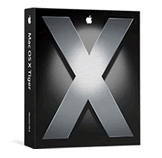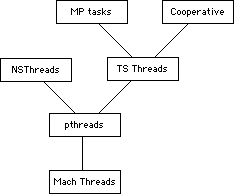No more mysteries: Apple's G5 versus x86, Mac OS X versus Linux
by Johan De Gelas on June 3, 2005 7:48 AM EST- Posted in
- Mac
Mac OS X: beautiful but...
The Mac OS X (Server) operating system can't be described easily. Apple:
While there are many very good ideas in Mac OS X, it reminds me a lot of fusion cooking, where you make a hotch-potch of very different ingredients. Let me explain.

Hexley the platypus, the Darwin mascot
Everything else is located in smaller programs, servers, which communicate with each other via ports and an IPC (Inter Process Communication) system. Explaining this in detail is beyond the scope of this article (read more here). But in a nutshell, a Mach microkernel should be more elegant, easier to debug and better at keeping different processes from writing in eachother's protected memory areas than our typical "monolithic" operating systems such as Linux and Windows NT/XP/2000. The Mach microkernel was believed to be the future of all operating systems.
However, you must know that applications (in the userspace) need, of course, access to the services of the kernel. In Unix, this is done with a Syscall, and it results in two context switches (the CPU has to swap out one process for another): from the application to the kernel and back.
The relatively complicated memory management (especially if the server process runs in user mode instead of kernel) and IPC messaging makes a call to the Mach kernel a lot slower, up to 6 times slower than the monolithic ones!
It also must be remarked that, for example, Linux is not completely a monolithic OS. You can choose whether you like to incorporate a driver in the kernel (faster, but more complex) or in userspace (slower, but the kernel remains slimmer).
Now, while Mac OS X is based on Mach 3, it is still a monolithic OS. The Mach microkernel is fused into a traditional FreeBSD "system call" interface. In fact, Darwin is a complete FreeBSD 4.4 alike UNIX and thus monolithic kernel, derived from the original 4.4BSD-Lite2 Open Source distribution.
The current Mac OS X has evolved a bit and consists of a FreeBSD 5.0 kernel (with a Mach 3 multithreaded microkernel inside) with a proprietary, but superb graphical user interface (GUI) called Aqua.
Performance problems
As the mach kernel is hidden away deep in the FreeBSD kernel, Mach (kernel) threads are only available for kernel level programs, not applications such as MySQL. Applications can make use of a POSIX thread (a " pthread"), a wrapper around a Mach thread.
Mac OS X thread layering hierarchy (Courtesy: Apple)
In order to maintain binary compatibility, Apple might not have been able to implement some of the performance improvements found in the newer BSD kernels.
Another problem is the way threads could/can get access to the kernel. In the early versions of Mac OS X, only one thread could lock onto the kernel at once. This doesn't mean only one thread can run, but that only one thread could access the kernel at a given time. So, a rendering calculation (no kernel interaction) together with a network access (kernel access) could run well. But many threads demanding access to the memory or network subsystem would result in one thread getting access, and all others waiting.
This "kernel locked bottleneck" situation has improved in Tiger, but kernel locking is still very coarse. So, while there is a very fine grained multi-threading system (The Mach kernel) inside that monolithic kernel, it is not available to the outside world.
So, is Mac OS X the real reason why MySQL and Apache run so slow on the Mac Platform? Let us find out... with benchmarks, of course!










116 Comments
View All Comments
wessonality - Friday, June 3, 2005 - link
ailleur2 - Friday, June 3, 2005 - link
Oh and the graph on page 5 doesnt display correctly in firefox.ailleur2 - Friday, June 3, 2005 - link
Well that was interesting.Im a big apple fan myself but even i never thought od putting osx server in a server room.
I think the g5 did quite well and had IBM delivered its promise of a 3ghz g5 (and that was supposed to be a year ago) the g5 would have won a couple of tests by a good margin.
If apple/IBM want altivec optimisations, i think theyll have to do it themselves since the interest level is pretty low.
One question though, why wasnt linux installed of the g5 if this was a cpu test? I dont know if it makes a damn of a difference but it whould have put them on equal bases.
Methodical - Friday, June 3, 2005 - link
I like anands articles way better.Your drawing too many conclusions off of data you basically call untrustworthy, but I agree your basic conclusion. The OS still needs more work.
I really think leaving out After Effects was a bad idea. Its a perfect benchmark. Plugins that do the exact same calculations on the exact same workfiles. Its also one of the biggest things these macs are used for, but I understand your article to be a bit more server-oriented.
Bahlo - Monday, December 13, 2021 - link
Actually, for better or worse the GCC Apple includes is being used for most Mac OS X software. OS X itself was compiled with it. https://setbitv.com/Bahlo - Thursday, May 5, 2022 - link
jhagman, the number in the apache test table means the request per second that the server handles.https://setbitv.com/abonnement-iptv1/